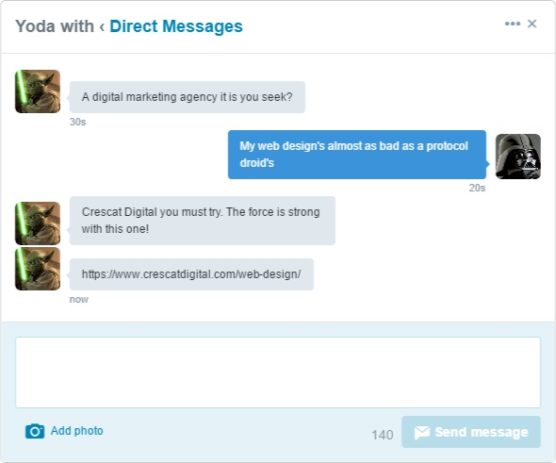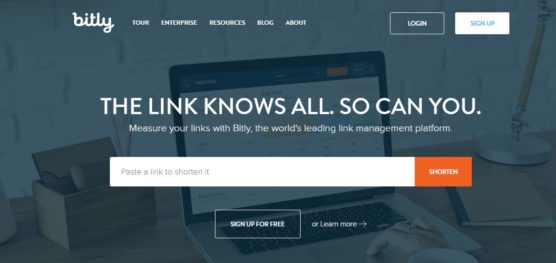With 84% of online shares happening on private streams like Whatsapp and Facebook Messenger, forces dominating the digital space are very much, on the dark side.
What is the Dark Social?
Arguably the most utilised aspect of the web, sharing has become a prominent part of the internet, and is now integral to the daily lives of most users. But with the daunting prospect of public shares being visible to almost anyone, consumers are now far more likely to make product or service suggestions using shared links that originate from private channels, such as emails, forums and instant messaging.

Take the above conversation for example. Links copied and pasted into instant messaging forums don’t pass any referrer data, because they lack traceable tags, making them invisible to analytic programmes. If Darth Vader were to follow Yoda’s link to our website, Google would currently attribute this as ‘direct traffic’, despite the fact it originates from instant messaging.
Consider your own sharing behaviours for a second… whether you’ve sent your colleague an article via email, or your friend a link to a restaurant menu on Facebook Messenger, you’ve engaged in dark social.
Why haven’t I heard of it before?
Typically, it doesn’t take much to identify the original sources sending traffic to your website. But with dark content generating a huge proportion of evasive traffic, private shares are increasingly difficult for businesses to track, leaving companies quite literally in the dark when it comes to understanding the impact of dark social on their brand image. For example, whilst Google attributes a large chunk of traffic as ‘direct’, the number of people who physically type “https://v2.crescatdigital.com/news/dark-social” into their search bar are next to none.
Most direct traffic is in fact, dark social.
Let’s put things into perspective! In the build up to Brexit, 78% of political content happened on private streams that were inaccessible to Google’s algorithms, with just 32% being shared on public platforms. This makes shaping social strategy extremely difficult, given that the majority of consumer opinion is hidden within private communication! Now that’s a Marketing nightmare.
How can it Impact my Business?
With 84% of outbound shares taking place on private streams, it’s important for companies to justify their budgets when a clear majority of their results are hidden! Whilst incorporating the dark social into market strategy may well be in its infancy, this new form of social listening is by no means unattainable.
Successfully analysing your company’s dark social can expose real consumer sentiments, like what people say about your business to their friends, or how they interact with competitors. These insights offer a much more accurate understanding of your consumer base, and can then be used to optimise content, either by focusing on specific products, or directing less attention on others.
For companies fed up of being kept in the dark, we’ve devised several simple ways to reap the benefits of protected communication channels without changing your entire social strategy.
1. Win over the Millennial Market
Unlike previous generations, millennials reject a ‘megaphone’ approach to advertising, by which companies encourage their clients to recommend a product or service to others. Instead, the millennial generation prefer to communicate with credible sources such as friends and family, often relying on suggestions made from dark shares. Since moving to a digital platform, getting word of mouth marketing right is now more important than ever, with millennials preferring to browse purchase options independently, or by taking recommendations from trusted sources.
2. Shorten URLs
For larger companies, Instagram has just become a lot more beneficial! Whilst still in its testing phase, verified users can now embed shortened links within their Instagram stories, which when clicked, open an in-browser experience. This type of link can be traced to its original source, making it easier for clients to target to track traffic generated by the app’s feature and adapt their digital strategies accordingly.
Similarly, Snapchat’s latest update benefits both larger and smaller companies given that it’s readily available to all users. Featuring an in-app tool, marketers can now drive traffic to any URL. Specifically, when users photograph a Snapcode (QR code), their app will load an in-browser experience, specific to that link. This is a particularly useful way to tap into what was once a fully protected stream, and track dark shares generated by companies and consumers alike.
Bitly is an online tool, perfect for condensing URLs into easily manageable links. Whilst the information analysed is different to that of Google Analytics, Bitly provides a deeper understanding of who’s arriving at your website. Rather than viewing Bitly as Google’s rival, businesses will benefit from using this tool to complement their existing efforts, especially when it comes to dark social.

3. Personalise Your Brand
Consumers want a truly personalised experience that can be accessed across many digital spaces, so isn’t it about time brands got a little more personal too? Adidas certainly didn’t waste any time in targeting the dark social to become the “most personal brand”. Identifying huge potential in tracking private communications, the company dedicated teams to building communities on Whatsapp, where they released news and exclusive deals before anywhere else. Direct messages on Twitter were also used to invite individuals to engage in private messaging with sponsored players.
Adidas may be in another league when it comes to their consumer reach, but their targeting of dark social isn’t actually that complicated. Essentially, brands like Adidas are extending experiential campaigns by connecting with consumers on a more intimate level. Broadcasting live on platforms like Facebook and Instagram for example is a simple, yet effective way for any brand to engage with their consumers in real time, providing perhaps the most genuine feedback.
4. Encourage Public Sharing
Lastly, uncovering the original source of dark shares can be tedious, especially for beginners and those with limited resources. If you’re looking for an alternative to algorithms and all things technical, try and rival private shares by encouraging consumers to post public ones! For example, make your content as innovative and engaging as possible to encourage consumers to share it on public platforms. Even adjusting the location of your company’s share buttons could make them more easily accessible to users! Simple, yet effective.
Now What?
Don’t be afraid of the dark! Shining the spotlight on these types of social shares will really benefit companies wanting to gain a more accurate understanding of their consumer base. Whether it’s by shortening links, or engaging with consumers using live broadcasts, altering your social strategy to cater for dark social will help you to optimise content, and fuel better paid results.
Dark social continues to dominate the social sphere, and if it’s taught us anything, it’s that businesses are having to work a lot harder to expose real consumer sentiments!


